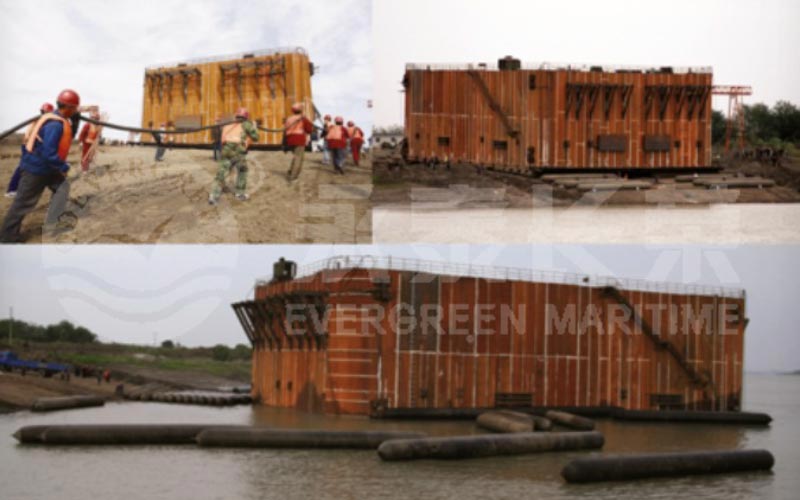Qingdao Evergreen Maritime Co., Ltd has laid two giant steel cofferdams for China Railways, as shown on photograph below.
In recent years, the airbag launching technology has developed rapidly. The advantages of the technology, such as its flexibility in safety and tolerance for submersible conditions, have made it widely used not only in the field of submarine discharge, but also in the fields of water engineering construction. The typical representative is the component airbag launching, such as the gravity caisson in the wharf construction and the large cofferdam air bag launching in the bridge construction.
Qingdao Evergreen Maritime Co., Ltd. launched two huge steel cofferdams, weighing 2800 tons and 2580 tons, respectively, for the China Railway Bridge Administration, creating a precedent for air bag launching of super large components.

A cofferdam is a structure that acts as a water shield in the construction of a bridge foundation to drain the water within the cofferdam, dig a pit, etc. At present, double-layered steel cofferdams are mostly used. There are many differences between air bag launching of steel cofferdam and ship launching. Firstly, there is the problem of airtightness. Secondly, because it is temporary watering, the slope is basically cemented and hardened to the natural slope, and the shallow water entry is usually filled with silt, which requires specific measures. Due to the heavy weight of the cofferdam and the depth of the water, the submerged waters need to be excavated.
The steel cofferdams that were laid down this time are the water construction platforms for the main tower of the bridge. The cofferdams No.3 and No.4 are the same size, 57 meters long, 35 meters wide and 16 meters high. The area is larger than two basketball courts and taller than a five-storey building, and the weights are 2,800 tons and 2,580 tons, respectively.
According to the plan, the embankment was laid with steel supporting panels before launching, ensuring the flattening and uniform pressure of the air bag carrying surface during launching. After the siding falls into the water, the tray can fall off on its own and sink to the bottom. In order to prevent a component from shifting its position under the current of the water, a traction rope at the front of its upper stream was set up.
It took 4 hours to raise the cofferdam by inflating airbags and remove the supporting block: 2 hours to remove the positions and adjust the airbags before launching: 58 seconds for the components from the start of launching to fully floating.
Most of the traditional methods of launching the giant steel cofferdams uses first construction of a drilling platform, after completion, dismantling the platform for steel crane divisions: or hire a sliding drilling terminal, transport steel crane subunits to the terminal, and then assemble and launch by sliding slipway. Compared with the air bag launching technology, the traditional technology has the disadvantages of long construction cycle, high cost and long water transport distance. The launching by air bags can be used to construct temporary slides according to local conditions, and the launching is one-time after the entire installation of the cofferdam on the land. The process is simple, which can save a lot of time and bring huge economic and social benefits.
The cofferdam air bag launching, as an extension of the air bag launching technique, is more and more widely used in the launching of hydraulic components because of its flexibility, convenience and remarkable economic efficiency. At the same time, worldwide, a heat wave is rising for air bag engineering.
